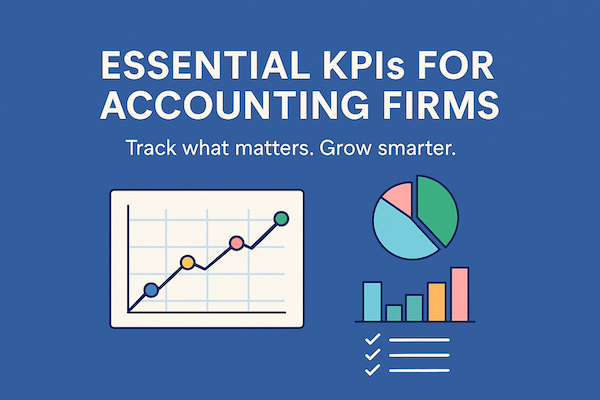Looking for accounting firm KPIs that are actually useful? This guide outlines realistic, high-impact metrics that small and mid-size firms can start tracking today to improve revenue, efficiency, and client satisfaction.
Use this guide as your KPI blueprint to track what matters most.
KPI Categories Covered in This Guide
We’ve grouped KPIs into six practical categories:
- Financial KPIs – Track profit margins, revenue, and cash flow
- Client KPIs – Measure retention, revenue per client, and satisfaction
- Operational KPIs – Understand task efficiency and team output
- Time-Based KPIs – Monitor realization, utilization, and effective hourly rates
- Cash Collection KPIs – Stay on top of receivables and payment cycles
- Technology & Staff KPIs – Track tool adoption and employee engagement
KPI Summary Table
| Category | KPI | Formula / Description |
|---|---|---|
| Financial | Gross Profit Margin | (Revenue - Direct Costs) ÷ Revenue |
| Net Profit Margin | Net Income ÷ Revenue | |
| Monthly Recurring Revenue (MRR) | Total value of ongoing monthly retainers | |
| Cash Flow Forecast Accuracy | Compare forecasted vs. actual cash on hand | |
| Client | Client Retention Rate | (Clients at End - New Clients) ÷ Clients at Start |
| Average Revenue Per Client | Total Revenue ÷ Number of Clients | |
| Client Acquisition Cost (CAC) | Marketing & Sales Spend ÷ New Clients | |
| Net Promoter Score (NPS) | % of clients who would recommend you (1–10 scale) | |
| New Client Growth Rate | (New Clients ÷ Clients at Start) × 100 | |
| Operational | Task Completion Rate | Completed Tasks ÷ Assigned Tasks |
| Average Task Duration | Time to complete key workflows (e.g., onboarding, returns) | |
| Billable Hours Ratio | Billable Hours ÷ Total Hours Worked | |
| Time-Based | Utilization Rate | Billable Hours ÷ Total Hours Worked |
| Realization Rate | Billed Amount ÷ Value of Billable Time | |
| Effective Hourly Rate | Total Revenue ÷ Total Hours Worked | |
| Cash Collection | Days Sales Outstanding (DSO) | (Accounts Receivable ÷ Sales) × 30 |
| Collection Rate | Collected Amount ÷ Total Invoiced | |
| Tech & Staff | Software Utilization Rate | % of staff actively using core tools |
| Training Hours per Employee | Time spent learning tools or improving workflows | |
| Staff Turnover Rate | Departures ÷ Total Staff |
Key Takeaways
- Focus on simple KPIs that drive growth, efficiency, and retention.
- Prioritize what’s measurable inside your firm—avoid vanity metrics.
- Use KPIs to make weekly and monthly decisions, not just annual ones.
Financial KPIs for Firm Stability
1. Gross Profit Margin
Formula: (Revenue - Direct Costs) ÷ Revenue
Tracks profitability before overheads.
Target: 40–60%
2. Net Profit Margin
Formula: Net Income ÷ Revenue
Measures total firm profitability.
Target: 20–30% for small firms
3. Monthly Recurring Revenue (MRR)
Sum of all ongoing monthly retainers.
Use for forecasting and planning capacity.
4. Cash Flow Forecast Accuracy
Compare forecasted vs. actual bank balances.
Use a simple spreadsheet and update weekly.
Client KPIs
5. Client Retention Rate
Formula: (Clients at End - New Clients) ÷ Clients at Start
Track quarterly or annually.
Target: 90%+ retention annually
6. Average Revenue Per Client (ARPC)
Formula: Total Revenue ÷ Number of Clients
Segment clients to identify low-value accounts.
Tip: Segment ARPC by service type (e.g., tax-only vs. full-service clients) for more insight.
7. Client Acquisition Cost (CAC)
Formula: Sales & Marketing Spend ÷ New Clients
Evaluate ROI on marketing and outreach.
8. Net Promoter Score (NPS)
Ask: “How likely are you to recommend us?” (1–10 scale)
8+ is strong. Use Google Forms or Typeform.
9. New Client Growth Rate
Formula: (New Clients ÷ Total Clients at Start of Period) × 100
Helps you track whether marketing, referrals, or outreach is paying off.
Operational Efficiency KPIs
10. Task Completion Rate
Formula: Completed Tasks ÷ Assigned Tasks
Monitor workflow bottlenecks.
11. Average Task Duration
Track how long typical work takes (e.g., onboarding, tax prep).
Use this to balance workloads and set expectations.
12. Billable Hours Ratio
Formula: Billable Hours ÷ Total Hours Worked
Even for fixed-fee firms, this helps monitor workload value.
Target: 70–80%
Time-Based KPIs (Even for Fixed-Fee Firms)
Tracking time helps evaluate efficiency, client profitability, and staff capacity—even if you don’t bill hourly.
13. Utilization Rate
Formula: Billable Hours ÷ Total Hours Worked
Measures how much of team time is spent on client work.
Target: 70–85%
14. Realization Rate
Formula: Billed Amount ÷ Value of Billable Time Recorded
Shows how much of your time entries convert into revenue.
Target: 90%+
Example: 20 billable hours at $100/hour = $2,000. If you invoice $1,800, your realization rate is 90%.
15. Effective Hourly Rate
Formula: Total Revenue ÷ Total Hours Worked
Helpful for analyzing profitability per client or service.
Example: $1,000/month retainer with 10 hours of work = $100/hour.
Cash Collection KPIs
16. Days Sales Outstanding (DSO)
Formula: (Accounts Receivable ÷ Total Sales) × 30
Track how quickly you’re paid.
Goal: Under 30 days
17. Collection Rate
Formula: Collected Amount ÷ Total Invoiced
Watch monthly to ensure good cash flow.
Goal: 95%+
Technology & Staff KPIs
18. Software Utilization Rate
What % of staff use your core tools regularly?
Spot underused systems and training gaps.
19. Training Hours per Employee
Track time spent learning new systems or workflows.
Well-trained staff are more efficient and stay longer.
20. Staff Turnover Rate
Formula: Departures ÷ Total Staff
Identify signs of burnout or culture issues.
Healthy rate: Under 15% annually
How KPI Priorities Change as Your Firm Grows
For Smaller Firms (1–10 people)
- Focus: Cash flow, margins, client retention
- Tools: Manual tracking (Google Sheets, Excel)
- Goal: Stay lean and profitable
For Growing Firms (10–50+ people)
- Focus: Team productivity, hiring, service line profitability
- Tools: KPI dashboards, time tracking, reporting tools
- Goal: Scale without losing visibility or control
Using a KPI Dashboard
Start with 5–7 core metrics in a shared dashboard.
Use tools like Google Sheets, Excel, or your practice software.
Tools like Jetpack Workflow, Karbon, Canopy, or Xero Practice Manager can also support this if you want more automation.
Review KPIs monthly, assign metric owners, and take action.
Frequently Asked Questions
What are the most important KPIs for small accounting firms?
Start with Gross Profit Margin, Client Retention Rate, Billable Hours Ratio, and DSO. These cover your financial health, client stickiness, team efficiency, and cash collection.
How can I track KPIs without expensive software?
Use simple tools you already have—Google Sheets, Excel, or built-in reports from your practice management system. Start small and build as you grow.
What is a good net profit margin for an accounting firm?
For smaller firms, 20–30% is a common target. If you’re consistently under 15%, revisit pricing or efficiency.
How do I improve my client retention rate?
Measure it first. Then improve communication, streamline delivery, and be proactive about renewals or check-ins. A simple portal for file sharing and updates also helps.
What KPI shows how efficient my team is?
Billable Hours Ratio and Utilization Rate are key. You can also track Average Task Duration to spot process gaps.
How often should I review KPIs?
Monthly is ideal. Some operational KPIs might be worth checking weekly. Make it part of your regular team review rhythm.
Summary
You don’t need dozens of KPIs to run a great firm. Start with a few that directly impact your decisions, track them consistently, and use them to guide improvements. Whether you're solo or scaling, the right KPIs will help you stay focused, efficient, and profitable.


